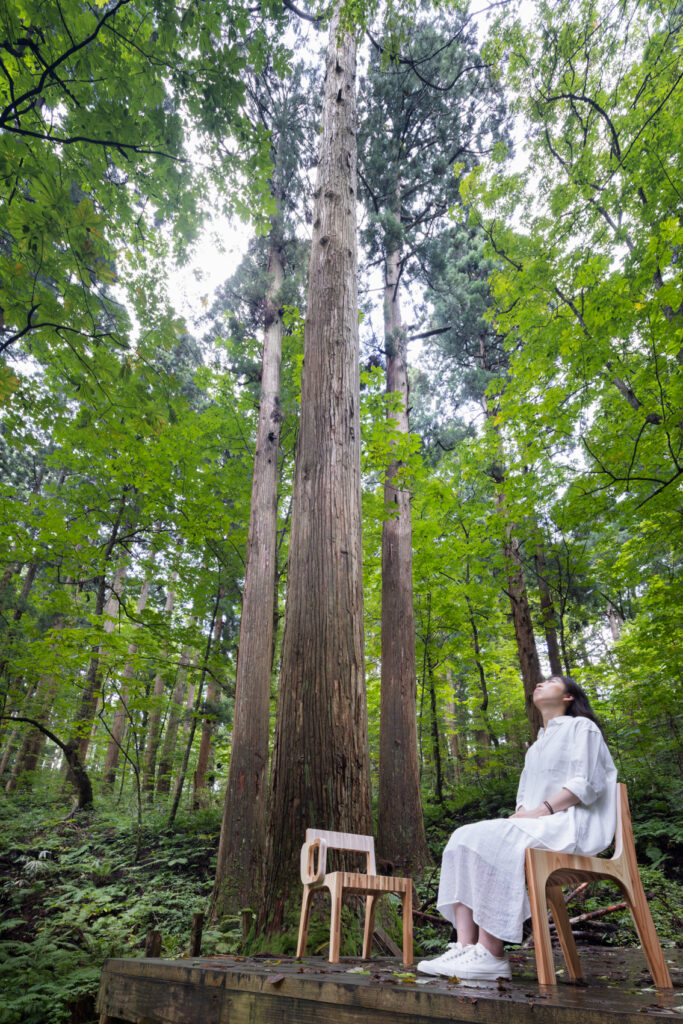GILIGILI KAGU PROJECT LAMINA
〜秋田の美しいゴミ〜
2022年10月20日 「株式会社GILIGILI」を立ち上げました。
GILIGILIは、建築よりももう少し人の生活に寄り添うようなもの、ランドスケープというよりはガーデニングという方が近いかもしれませんし、家具や身の回りの物、雑貨みたいなもの、人が直接触れるようなものが世の中に送り出す主な媒体となることを考えています。記念すべき最初のPROJECTは、家具です。
コンセプトは、「秋田の美しいゴミ」。
全国でも景気が悪い県で上位に入っている秋田県(特に私の故郷の能代は秋田の中でも死滅する市とさえ言われています。)がKAGU PROJCTの生産の中心となり、捨てられていくもの(材料選定ではじかれた板や切り落とされた端材、忘れられて倉庫で眠っているもの等)を新しい技術とデザインの力で再生して、世の中に送り出すというものです。
能代はかつて木材の町として栄えました。当時の繁栄は、街の中を歩いていても感じられなくなくなりましたが、市内に残っている「旧料亭 金勇」では今でもみごとな天然秋田杉で造られた建築を見ることができます。能代に限らず、日本の木材産業は衰退してきましたが、市内には当時からの技術を継承し、全国を舞台に活躍している人達がいます。
そこで、私たちが素材として選んだのは、木製品の製作過程で残った半端ものの「秋田杉」。
能代の家具屋さんや建具屋さんが製品の製作過程で出てくる端材は、これまで倉庫の片隅に積まれ、ある一定量を超えると破棄され燃やされています。つまり最終的にはゴミとして処理されています。
燃やされた木材は、二酸化炭素を大気中に放出します。木材は、二酸化炭素を内部に蓄え大気中に拡散するのを防ぎます。このPROJECTは、SDGsにつながる小さな試みです。
半端ものの秋田杉はそのままではもちろん使えません。
LAMINAは、ゴミとして処理される半端ものの秋田杉の端材を重ねてプレスし、3層の板を作り、その板で造る家具です。
製作された家具は、もともと家具や建具の仕上げとして選ばれた材料で造りますから、節がほとんどなく、本来の秋田杉の製品と同様に木目や色あいがとても綺麗で柔らかく、人に優しい家具としてゴミから生まれ変わるという家具のシリーズです。
現在、椅子はスタンダードタイプ、肘掛け付き、スツール、ハイスツールの4種、テーブルはダイニングテーブルとローテーブルの2種の計6種の家具を展開し、2024年度から販売しています。

「新しい技術とデザインの力で、秋田のゴミを美しい家具として再生すると共に、故郷を再生したい。」
~Akita’s Beautiful Trash~
On October 20, 2022, we launched “GILIGILI Co., Ltd.”
GILIGILI focuses on things that are closer to people’s lives than architecture—perhaps closer to gardening than landscaping—and we envision furniture, everyday items, miscellaneous goods, and things people directly touch as the primary mediums we send out into the world. Our first project is furniture.
The concept is “Akita’s Beautiful Trash.”
Akita Prefecture, which ranks among the most economically depressed prefectures in Japan (my hometown, Noshiro, in particular, is said to be the dying city within Akita), will be the production center of the KAGU PROJECT, where discarded items (such as boards rejected during material selection, off-cut lumber, and forgotten items stored in warehouses) will be repurposed using new technology and design and sent back out into the world.
Noshiro once thrived as a lumber town. While the prosperity of those days is no longer felt when walking through the city, the former restaurant Kinyuu, which remains in the city, still features stunning architecture made from natural Akita cedar. Japan’s lumber industry has declined, not just in Noshiro, but there are people in the city who have inherited the techniques from that time and are active on a national stage.
That’s why we chose Akita cedar as our material: leftover wood from the manufacturing process of wooden products.
Until now, the scraps generated by furniture and joinery makers in Noshiro during the manufacturing process have been piled up in a corner of a warehouse, and once a certain amount was reached, they were discarded and burned. In other words, they ultimately ended up as waste.
Burned wood releases carbon dioxide into the atmosphere. Wood stores carbon dioxide internally, preventing it from escaping into the atmosphere. This project is a small initiative that contributes to the SDGs.
Of course, leftover Akita cedar cannot be used as is.
LAMINA is a furniture series made from off-cuts of Akita cedar that would otherwise be disposed of as waste, layered and pressed to create three-layered boards.
The furniture produced is made from a material originally selected for finishing furniture and building fixtures, so it is virtually knot-free and, like genuine Akita cedar products, has a beautiful, soft grain and color. It is a people-friendly furniture series that transforms waste into new life.
Currently, there are four types of chairs: standard, with armrests, stool, and high stool, and two types of tables: dining table and low table, for a total of six types of furniture, which will be on sale from 2024.
“Through the power of new technology and design, we want to recycle Akita’s waste into beautiful furniture and revitalize our hometown.”
